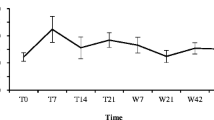Abstract
It is well established that pregnancy induces physiological, metabolical and hormonal changes. As a consequence, trace metal metabolism can be affected. The aim of the present study was to assess the urinary cadmium levels in women during gestation and postpartum. The survey was conducted in a group of nonoccupationally cadmium-exposed women from Southern Catalonia (NE, Spain). Urine samples were obtained before pregnancy, during the 6th, 10th, 26th, and 30th wk of gestation, as well as during the 5th and 24th wk after delivery. Urinary cadmium levels were determined by graphite furnace atomic absorption spectrophotometry. The concentrations of zinc and copper in plasma were also measured. Moreover, to assess the effect of the diet during pregnancy, dietary ingestions of zinc, iron, and calcium were also determined. A significant decrease of plasma zinc levels could be observed during the last two trimesters of pregnancy, while plasma copper concentrations significantly increased during the same period. Urinary cadmium concentrations ranged from 0.05 to 3.79 μg/g creatinine (geometric mean 0.49±2.26 μg/g creatinine). No significant changes in urinary cadmium concentrations during pregnancy and postpartum could be observed.
Similar content being viewed by others
References
R. Newhook, G. Long, M. E. Meek, R. G. Liteplo, P. Chan, J. Argo, and W. Dormer, Cadmium and its compounds: evaluation of risks to health from environmental exposure in Canada.Environ. Carcino. Ecotox. Revs. C12, 195–217 (1994).
M. P. Waalkes and S. Rehm, Cadmium and prostate cancer,J. Toxicol. Environ. Health 43, 251–269 (1994).
M. Piscator, Dietary exposure to cadmium and health effects: impact on environmental changes,Environ. Health Perspect. 63, 127–132 (1985).
Y. Hochi, T. Kido, K. Nogawa, H. Kito, and Z. A. Shaikh, Dose-response relationship between total cadmium intake and prevalence of renal dysfunction using general linear models.J. Appl. Toxicol. 15, 109–116 (1995).
R. R. Lauwerys, A. M. Bernard, J. P. Buchet, and H. A. Roels, Assessment of the health impact of environmental exposure to cadmium: contribution of the epidemiologic studies carried out in Belgium,Environ. Res. 62, 200–206 (1993).
M. Schuhmacher, M. A. Bosque, J. L. Domingo, and J. Corbella, Lead and cadmium concentrations in autopsy tissues of inhabitants of Tarragona Province, Spain,Trace Elem. Med. 10, 115–119 (1993).
F. Schweinsberg and L. von Karsa, Heavy metal concentrations in humans,Comp. Biochem. Physiol. 95C, 117–123 (1990).
H. Korpela, R. Loueniva, E. Yrjanheikki, and A. Kauppila, Lead and cadmium concentrations in maternal and umbilical cord blood, amniotic fluid, placenta, and amniotic membranes,Am. J. Obstet. Gynecol. 155, 1086–1089 (1986).
B. R. Kuhnert, P. M. Kuhnert, and T. J. Zarlingo, Associations between placental cadmium and zinc, age and parity in pregnant women who smoke,Obstet. Gynecol. 71, 67–70 (1988).
J. L. Domingo, Metal-induced developmental toxicity in mammals: a review,J. Toxicol. Environ. Health 42, 123–141 (1994).
N. Fréry, C. Nessmann, F. Girard, J. Lafond, T. Moreau, P. Blot, J. Lellouch, and G. Huel, Environmental exposure to cadmium and human birthweight,Toxicology 79, 109–118 (1993).
E. van der Voet, L. van Egmond, R. Kleijn, and G. Huppes, Cadmium in the European Community: a policy-oriented analysis,Waste Managem. Res. 12, 507–526 (1994).
N. E. Kowal, D. E. Johnson, D. F. Kraemer, and H. R. Pahren, Normal levels of cadmium in diet, urine, blood, and tissues of inhabitants of the United States.J. Toxicol. Environ. Health 5, 995–1014 (1979).
H. Abe, T. Watanabe, and M. Ikeda, Cadmium levels in the urine of female farmers in nonpolluted areas in Japan.J. Toxicol. Environ. Health 18, 357–367 (1986).
T. Kawada, R. R. Shinmyo, and S. Suzuki, Urinary cadmium and N-acetyl-β-glucosaminidase excretion of inhabitants living in a cadmium-polluted area,Int. Arch. Occup. Environ. Health 63, 541–546 (1992).
M. Schuhmacher, M. A. Bosque, J. L. Domingo, and J. Corbella, Urinary cadmium levels in an unexposed population: relationship to age, sex, and smoking and drinking habits,Trace Elem. Electrol. 11, 38–41 (1994).
M. Schuhmacher, M. A. Bosque, J. L. Domingo, and J. Corbella, Effects of chronic lead and cadmium exposure on blood pressure in occupationally exposed workers,Biol. Trace Elem. Res. 41, 269–278 (1994).
I. Baranowska, Lead and cadmium in human placentas and maternal and neonatal blood (in a heavily polluted area) measured by graphite furnace atomic absorption spectrometry,Occup. Environ. Med. 52, 229–232 (1995).
M. Hernández, M. Schuhmacher, J. D. Fernández, J. L. Domingo, and J. Corbella, A longitudinal study of lead mobilization during pregnancy: concentrations in maternal and umbilical cord blood (submitted for publication).
L. Alessio, A. Dell'Orto, G. Calzaferri, M. Buscaglia, G. Motta, and M. Rizzo, Cadmium concentrations in blood and urine of pregnant women at delivery and their offspring,Sci. Total Environ. 34, 261–266 (1984).
C. Bonithon-Kopp, G. Huel, C. Grasmick, H. Sarmini, and T. Moureau, Effects of pregnancy on the inter-individual variations in blood levels of lead, cadmium and mercury,Biol. Res. Pregnancy Perinatol. 7, 37–42 (1986).
H. Roels, R. R. Lauwerys, J. P. Buchet, A. Bernard, J. S. Garvey, and H. J. Linton, Significance of urinary metallothionein in workers exposed to cadmium,Int. Arch. Occup. Health 52, 159–166 (1983).
H. M. Chan, Y. H. Tamura, M. G. Cherian, and R. A. Goyer, Pregnancy associated changes in plasma metallothionein concentration and renal cadmium accumulation in rats.Proc. Soc. Exp. Biol. Med. 202, 420–427 (1993).
B. L. Geller and D. R. Winge, Metal binding sites of rat liver Cu-thionein,Arch. Biochem. Biophys. 213, 109–117 (1982).
Y. Mitane, C. Tohyama, and H. Saito, The role of metallothionein in the elevated excretion of copper in urine from people living in a cadmium-polluted area,Fundam. Appl. Toxicol. 6, 285–291 (1986).
K. Suzuki, H. Tamagawa, K. Takahashi K, and N. Shimojo, Pregnancy-induced mobilization of copper and zinc bound to renal metallothionein in cadmium-loaded rats,Toxicology 60, 199–210 (1990).
N. W. Solomons Biological availability of zinc in humans.Am. J. Clin. Nutr. 35, 1048–1075 (1982).
Author information
Authors and Affiliations
Rights and permissions
About this article
Cite this article
Hernandez, M., Schuhmacher, M., Fernandez, J.D. et al. Urinary cadmium levels during pregnancy and postpartum. Biol Trace Elem Res 53, 205–212 (1996). https://doi.org/10.1007/BF02784556
Received:
Accepted:
Issue Date:
DOI: https://doi.org/10.1007/BF02784556




